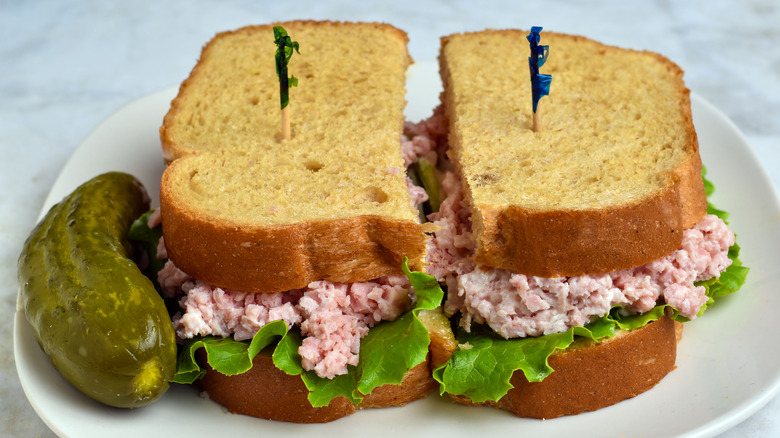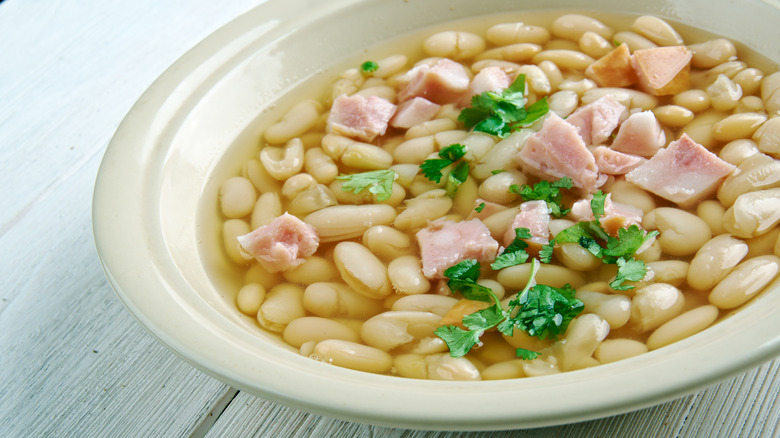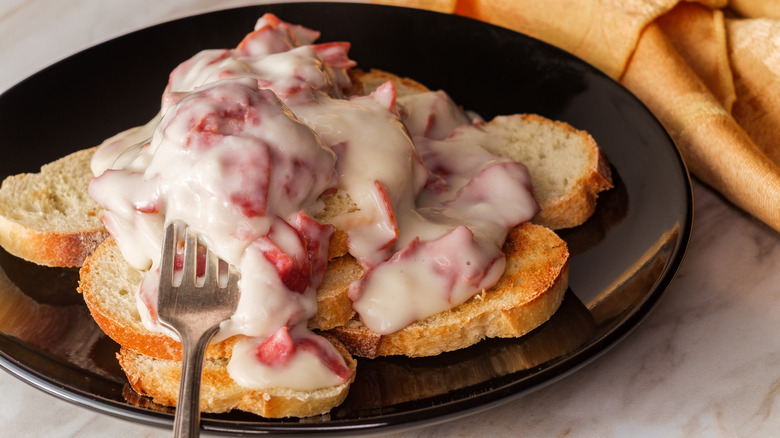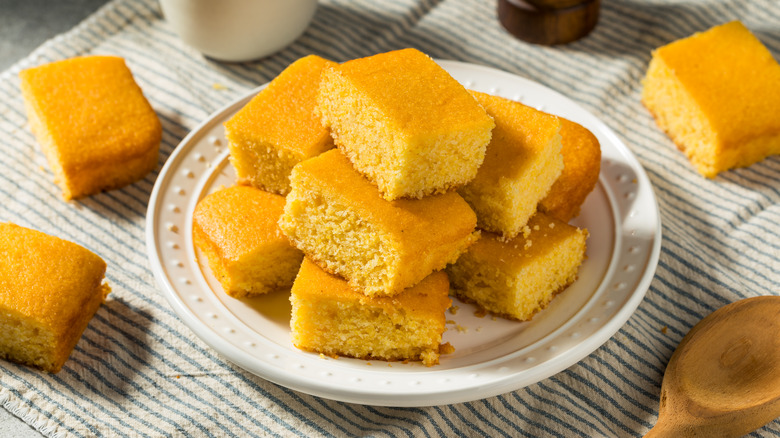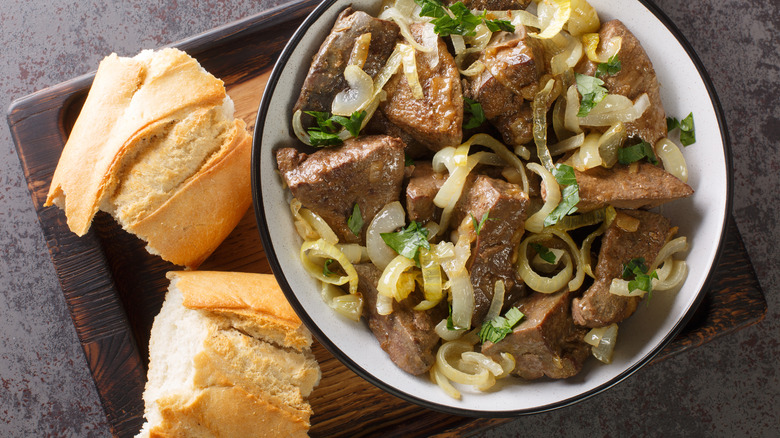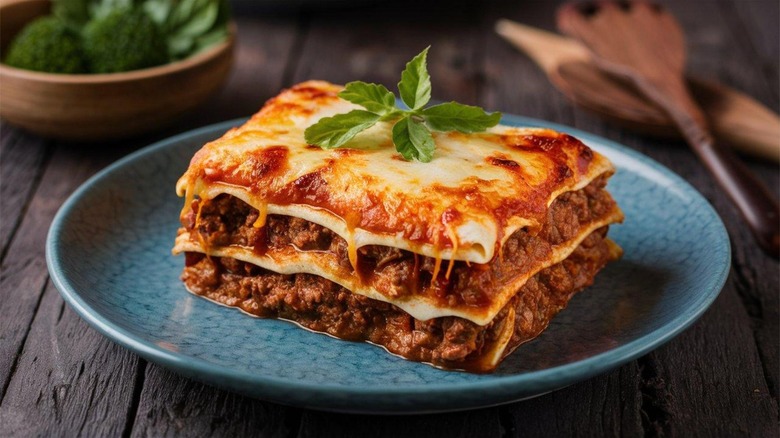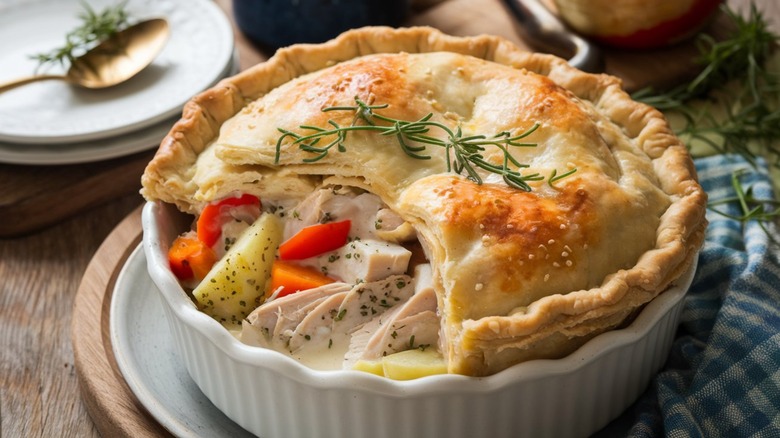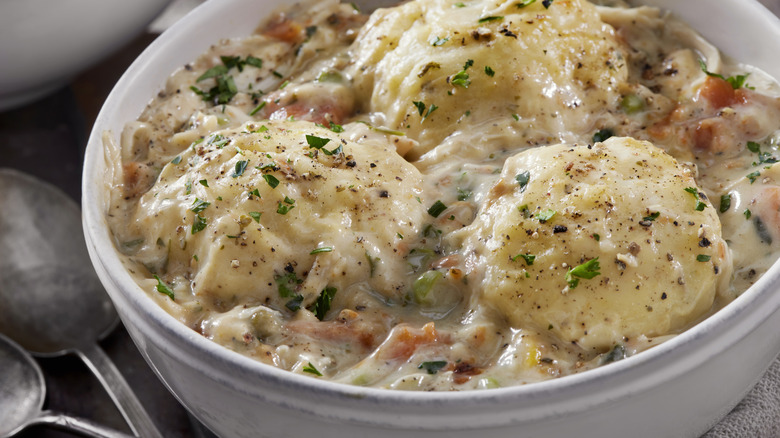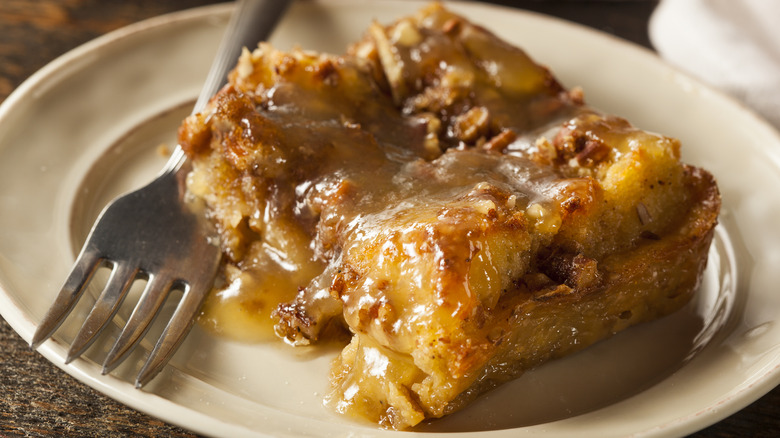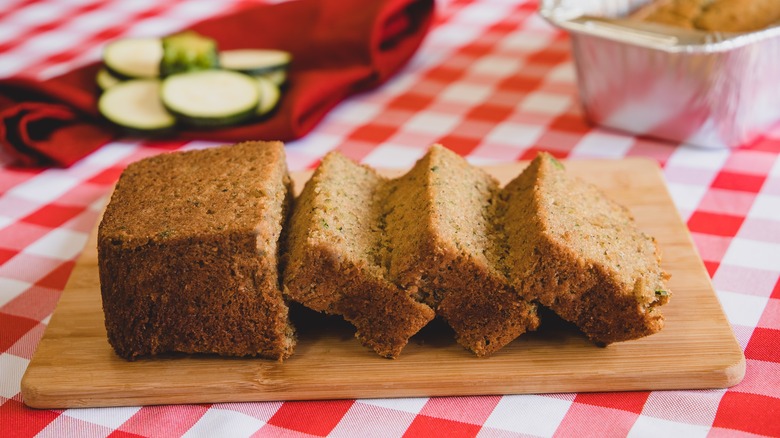15 Vintage Dishes Your Grandparents Probably Made All The Time
When you think of your grandparents, you may well think of Sunday dinners, Thanksgiving, or other holidays and family get-togethers centered around food. These memories bring back the smell and taste of dishes you've come to associate with your elders and generations gone by. There are countless recipes that trace their origins back to our grandparents' youth and younger adulthood, becoming staples in their diet for a number of different reasons. From stretching the family budget to feeding large groups of people in a timely (and ideally tasty) manner, these were the kinds of dishes that our forebears kept coming back to time and again.
We're here to take a closer look at some of these interminable salads soups, sides, and mains. While borne from bygone eras and some hard economic conditions, these dishes were integral to home cookery of the past (and in some cases, still are). They might induce memories of comfort, warmth, or even derision if you couldn't stand that green bean casserole you folks made you eat alongside your holiday turkey. Either way, they're worthy of recognition — grandparents are among the wisest people we know, so these dishes must have something going for them.
Ham salad
Ham salad is a favorite in the Southern United States due to it being easy to make, affordable, and convenient. As ready-to-eat canned hams became more available in grocery stores, home cooks found ways to create recipes with chopped hams and mix them with different ingredients. During the Great Depression, the affordability and resourcefulness of using canned hams to make a meal made ham salad the perfect dish at a time when every bit of food was precious and needed to both be stretched as long as possible and feed large groups of people. These factors may also be what made ham salad such a popular dish for post-funeral gatherings. You could make large quantities, throw it in a container, and bring them to the griever's house.
Ham salad has a salty, creamy, and crunchy taste to it. The salt comes from the ham or bologna, the mayonnaise that holds the dish together adds the creaminess, and the crunch comes from a variety of ingredients that may be added, such as pickle relish. Throughout the Southern United States, there are variations of what goes into ham salad. These variations include mixing in hard-boiled eggs, celery, onions, and even Dijon mustard. No matter how you make your ham salad, it's a great spread to put between two pieces of white bread or on a cracker.
Ham and bean soup
Ham and bean soup is an affordable meal that is packed with fiber and protein, making it perfect for a time when food had to be rationed. Additionally, it's great for meal prep since you can easily freeze and reheat to enjoy again. Some say that ham and bean soup tastes better when it rests in the fridge for a few hours or overnight. While this hearty soup was popular across America in our grandparents' generation, it has a long history in Washington, D.C. Called "Senate Bean Soup," it is a staple on the restaurant menus of the U.S. House of Representatives and the Senate.
This soup has a rich and smoky taste that is great at chasing those winter chills away. At its base, it contains navy beans, ham hocks, and vegetables. However, this soup is versatile enough that you can change it to fit your taste, swapping in replacements where necessary (for example cannellini beans instead of navy beans, or pork shank instead of ham hock). While there are many liberties you can take with ham and bean soup, it is recommended to use water instead of broth as the beans and ham hock make their own broth in the water, especially when you let it rest.
Goulash
Maybe you know this dish as American chop suey, but in the Midwest, it is known as American goulash. American goulash is a reimagining of Hungarian goulash. This dish is typically associated with comfort food and affordability. Like most dishes on this list, it is also adaptable, allowing home cooks to change the recipe based on whatever was in their fridge at the time or what type of beef was on sale at the grocery store. It also feeds a large crowd with ease, making it a go-to during hard economic times.
As a one-pot pasta dish that is typically made with elbow macaroni and ground beef, goulash can feed a large crowd with ease. It's simmered in a paprika-seasoned tomato sauce which fortifies its filling flavor. Goulash's inherent adaptability has led to variations across the globe, but if you're looking to go traditional and make original Hungarian goulash, you will use beef cubes, onions, carrots, potatoes, Hungarian paprika, caraway seeds, green peppers, and tomatoes.
Creamed chip beef on toast
Creamed chip beef on toast or S.O.S. (sh*t on a shingle, as it was lovingly called) originated as a simple, hearty, and cheap meal that can feed armies, literally. It is believe that this dish fed British sailors in the 1700s and American soldiers during both World Wars.
The dish itself is straightforward, consisting of chipped, dried beef that is cooked in a milk gravy and then served over toast. It's filling as-is, but can be made even more so by serving it over potatoes instead of toast. Because chipped beef comes pre-packaged and thinly sliced, whipping this dish up was the height of convenience and affordability. The most complicated part is making a simple roux for the milk gravy.
Sweet potato casserole
Sweet potato casserole continues to be a mainstay Thanksgiving tables, with some recipes passed down within families for generations. However, the sweet potato casserole we know today was popularized after the Angellus Marshmallow Company published a recipe booklet that included a recipe for baked sweet potatoes with marshmallows on top. Sounds a bit like an inside job, no? Regardless, the sweet addition to the already-sweet tubers made the casserole a holiday favorite that's stood the test of time topping did not appear on Thanksgiving tables until 1917 when a popular recipe booklet published by the Angelus Marshmallow Company included the recipe "sweet potatoes baked with marshmallow topping."
This dish often brings feelings of comfort, warmth, and tradition. Typically, sweet potato casserole will include sweet potatoes, butter, brown sugar, heavy cream, cinnamon, nutmeg, salt, vanilla, and topped with mini marshmallows. However, if you find that marshmallow is too sweet for your taste, some recipes call for a walnut topping.
Beef stroganoff
Beef stroganoff is a comforting and hearty dish that became popular in the United States in the 1950s and 1960s. It became popular as it does not require you to be an expert in the kitchen, has a short list of ingredients, and is flexible to whatever you have in your fridge or pantry.
Typically, beef stroganoff contains strips of sirloin beef sautéed in onions and mushrooms. This is then simmered in a creamy sauce made with sour cream, or canned mushroom soup. Some serve the dish over rice or egg noodles. There are variations of beef stroganoff throughout the world. This dish is so flexible that home cooks have experimented with using different ingredients such as liver instead of beef or adding carrots, prunes, melted cheese, wine, or nutmeg to the mix.
Cornbread
What started as a Native American innovation has become a cornerstone of dinner tables throughout the American South. Cornbread became popular because the crop itself is easy to grow and source, making it a convenient and cost-effective way to whip up a filling side dish. Second, it is an easy to make, crowd-pleasing dish that has found its way as a staple at potlucks and church gatherings. It's so ubiquitous Southern cooking that you may even have a family recipe that has been handed down through generations.
At its base, cornbread is typically made with cornmeal, butter or lard, and milk. Some add sugar to make the bread a little bit sweeter. There are regional variations of cornbread throughout the United States such as adding buttermilk and baking powder, nuts, baked beans, cheese, or even jalapeños to the batter. Its versatility makes it perfect as a side dish used to soak up gravies and sauces or even as the main dish on your dinner table.
Tater tot casserole
Tater tot casserole, or tater tot hotdish if you're Midwestern, is an easy-to-make dish that can feed a large family on a tight budget. Casseroles, or hotdishes, were a resourceful way to get a filling meal without having to buy extra ingredients, especially during the Great Depression. While casseroles were already popular, it was not until the 1960s or 1970s that crispy tater tots were added to the top. Tater tots were invented during the early 1950s when Ore-Ida, already well known for french fries, was trying to find a way to utilize the leftover potato scraps. Instead of throwing them out, the brand came up with another crunchy, fried snack. Once these crispy tots started hitting the grocery stores, home cooks started topping their casseroles with them.
At its core, tater tot casserole consists of ground beef, canned soup (like cream of mushrooms or cream of chicken), vegetables (like corn or green beans), and crispy tater tots on top. Some cooks also include cheese, onions, spices, broccoli, or peppers and some even swap out the ground beef for chicken or sausage. While this started as a simple dish in times of economic uncertainty, today, you can find more upscale tater tot casseroles with ingredients such as truffle oil.
Green bean casserole
Green bean casserole, another Thanksgiving table favorite, was created in 1955 in the Campbell's Test kitchen by Dorcas Reilly. Originally named "green bean bake," it was advertised as an easy-to-make dish that uses items that are already in your kitchen. According to Campbell's, the green bean casserole recipe gets 4 million views each Thanksgiving.
The original green bean bake recipe from Campbell's included green beans (usually canned or frozen, cream of mushroom soup (Campbell's brand, of course), soy sauce, and topped with french fried onions. You can still see this recipe printed on the Campbell's cream of mushroom soup cans every holiday season. The original, hand-written recipe from Dorcas Reilly was inducted into the National Inventors Hall of Fame in Akron, Ohio in 2022. While the original called for french fried onions on top, some home cooks experiment with almonds, potato chips, or cracker toppings, instead, and in some households, the soy sauce is not included.
Liver and onions
The 20th century popularity of liver and onions, like many other dishes on this list, can be summed by three main factors: It's cheap, quick, and nutrient dense. No wonder its popularity skyrocketed during the Great Depression and World War II. Liver and onions is packed with vitamin A, B, iron, and other nutrients, providing an easy way for families to get the most out of their meals when budgets were tight and pantries were relatively scarce.
Liver and onions is commonly associated with Jewish cuisine and is still commonly available at kosher delis and restaurants. To combat the rich and strong taste of the liver, it was found that onions were the perfect sidekick with their caramelized sweetness. To further subdue the strong taste, it is recommended to soak the liver in milk before you start to cook your liver and onions dish. Liver and onions can be eaten on their own, but most serve it with mashed potatoes, rice, noodles, steamed vegetables, or bread.
Beef lasagna
It might not come as a surprise that lasagna originated from Italy as a way to feed a lot of people and still have leftovers. Lasagna grew in popularity due to its versatility and variations began to pop up all over the world. In the United States, popularity for lasagna started in the 1950s when the Boitoni Company of New York started selling frozen lasagna that people could thaw and cook at home. In addition to the convenience of purchasing frozen lasagna, beef and dairy were a staple in American cuisine during the '50s, making it easy and affordable to make your own lasagna from scratch. This dish became so popular in the United States that it even has its own national day on July 29th.
A typical American beef lasagna contains lasagna noodles, meat, cheese, a tomato-based sauce, and then more lasagna noodles. This pattern continues until a nice stack is formed. With its versatility, some include vegetables, create a seafood version, or even create a vegetarian version. There is even a variation called a Mexican lasagna that uses tortillas instead of lasagna noodles and includes beans and salsas.
Chicken pot pie
Chicken pot pie is a classic comfort food perfect for those colder months. With roots that trace back to medieval England, this dish started to show up in American homes in the mid-1900s when families needed to quickly and easily prepare meals that would use their leftover meat for that week. This popularity only grew when companies like Swanson began producing frozen and canned versions, making it even easier for families to put this delicacy on the table.
The basics of chicken pot pie include a chicken and vegetable filling enclosed in a pastry crust. Over time, the recipe has changed with some including potatoes to make the dish more filling or using puff pastry crust for a flaky pie. Like most recipes, there are variations including some that use beef, seafood, or even plant-based filling. Lancaster, Pennsylvania is even known for its version of chicken pot pie that uses square noodles instead of the pastry crust.
Chicken and dumplings
Like chicken pot pie, chicken and dumplings is a hearty chicken dish that captured the heart of midcentury Americans. Though versions can be found in recipe books dating back to the mid-1800s, chicken and dumplings experienced a boon when chicken became more commercialized and easy to afford in the 1950s and '60s. Plus, canned and frozen versions started hitting grocery shelves around the same time. Affordable, convenient, and filling — that's the name of the game, isn't it?
Early versions of chicken and dumplings included a cornmeal dumpling with turnip greens. The dish we know today, typically includes chicken, broth, and a fluffy biscuit dough dumplings. As with most dishes, there are regional variations throughout the United States, such as the Pennsylvania Dutch bott boi, which is a cross between chicken and dumplings, chicken pot pie, and the Southern chicken and pastry. Some home cooks adapt their recipes to include baking powder, fresh herbs, different parts of the chicken, or even a rotisserie chicken.
Bread pudding
Originally called "poor man's pudding," bread pudding started as a way to prevent wasting bread. Instead of throwing out their stale bread, home cooks would soak it in a sweet liquid, bake it, and then serve it warm. Bread pudding became especially popular during World War II, when food budgets had to stretch and recipes that utilized ingredients already in the pantry were common.
The basic structure of bread pudding is cut or torn pieces of bread in a custard sauce that is baked in the oven. The sauce usually contains eggs, butter, milk or cream, sugar, and spices like cinnamon or vanilla. After it is baked, it has a soft and spongy consistency resembling pudding or custard. Bread pudding is another versatile dish with variations that include adding brown sugar, raisins, apple, maple syrup, chocolate, nuts, candied citrus peels, cheese, bacon, mustard, and even Kentucky bourbon.
Zucchini bread
Zucchini bread is a moist and flavorful quick bread inspired by other vegetable based goods like carrot cake or pumpkin bread. It came about in the early 1900s when people were looking for ways to use up their bumper zucchini crops. The first written recipe for zucchini bread appeared in 1940, and became popular due to its reputation as a healthier alternative to sugary cakes and other sweet pastries.
One reason this dish was so popular was because it is a "quick bread," leavened with baking soda or baking powder instead of yeast, making it far easier — and, yes, quicker — to put together. Like most dishes during the time, it's extremely versatile and has led to several variations across regions. Some home cooks include cinnamon-nut, chocolate chip, lemon poppy seed, or even cheese and herbs in their zucchini breads.


